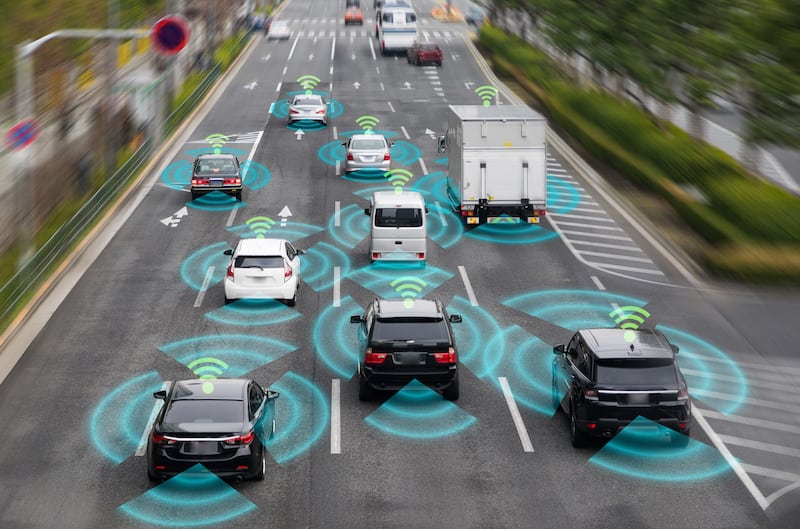Few automotive innovations have been as successful at saving lives as the seat belt. For more than 35 years, seat belts have helped reduced crash-related deaths and injuries by almost half.
Since it was created, the fundamental design of the seat belt has remained the same and it has served, along with airbags, as a primary source of in-vehicle protection for drivers. Today, with the automotive industry pushing the world closer to the era of connected, data-centric mobility, a new class of in-vehicle safety measures are also being advanced. Fuelled by the hyperconnectivity that technologies such as 5G are unleashing, these innovations are beginning to take a larger role in dictating the development and design of cars.
A move from reactive to preventative safety
5G will have a big impact on many sectors as it doesn’t just allow for connected assets to be monitored or tracked, but also controlled remotely in an extremely reliable way. Because of the low latency and greater capacity of 5G, there is also the ability to connect more objects without compromising on quality of service. For instance, thanks to the reliability of 5G, forklifts moving on the shop floor will be able to autonomously stop before colliding with someone crossing their paths.
The forklift case is a compelling example of why the most important automotive features associated with the enhanced connectivity 5G provides can be linked to safety. There’s no doubt that, for future mobility applications such as obstacle detection and autonomous driving, 5G can become the future infrastructure and platform of choice. This is also partially due to its nature: 5G is the latest global wireless standard, and is expected to cover one-third of the world’s population by 2025[1].

This is the landscape in which 5G will rise to the level of the seat belt for in-vehicle safety. But with a clear advantage: seat belts will always be reactive—they will help minimise the damage from incurring harm but can’t stop you from getting into an accident. The infrastructure enabled by 5G, on the other hand, helps to broaden the car features available that work in a preventative capacity, helping to protect not just the driver, but other road users, too. And with more than 70% of cars built in 2020 already equipped with telematics capabilities, the automotive sector is poised to make the most of the next-generation safety-enhancing connectivity options in the years to come.
The revolutionary safety capabilities of connected cars
Another example of how 5G is setting new standards in road safety is through assisted driving systems. Thanks to 5G, cars enabled with these systems use a range of sensors and cameras to navigate roads more safely, minimising the risk of accidents. And whether it is true that when a car is equipped with 5G capabilities the risks for road-users will be significantly reduced, the true power of the technology is only realised once that car can connect with others on the road and the surrounding environment.
When in-vehicle telematics are combined with technologies such as vehicle-to-everything (V2X ) and vehicle-to-vehicle (V2V), those cars become part of an interconnected, data-centric ecosystem, gaining access to a host of intelligent road controls. With each new car that joins that ecosystem, those controls are enhanced further. This means that cars can continuously share information with each other while on the road, giving drivers advanced warning of hidden obstacles and the ability to detect and avoid other road users. Features such as automatic emergency braking systems and assisted overtaking offer new, safer solutions to old driving challenges. These systems can even connect to nearby smartphones and protect pedestrians and cyclists from unseen risks while they’re near or crossing a road.
What’s more, 5G-powered mobility cloud platforms that link vehicles and infrastructure change the way vehicles and drivers interact with their environment, providing them with real-time, highly localised and targeted updates from road operators on lane closures, speed restrictions and traffic incidents. These platforms can also help emergency services recover vehicles in remote locations, help road authorities control and ease traffic jams, and make informed planning decisions using secure, anonymised, and aggregated vehicle position data.
The most important automotive features associated with the enhanced connectivity 5G provides can be linked to safety
A future unlocked by partnerships
The picture of the world painted above, where connectivity and 5G are central to road user safety, is one we should all not only look forward to but actively strive to achieve. Because the reality is, for these 5G benefits to be fully realised, companies and policymakers will need to work together.
There needs to be a concerted effort to educate the public about the importance of these innovations and their benefits. It needs public support in the form of policy, that will require political stakeholders, technology and automotive companies to come together to communicate its benefits. Only once a policy framework and support system are in place will the technology be able to roll out widely enough to have the desired impact on society. It’s not an easy task to change such an ingrained aspect of society as transportation but we are already on the right path. And if 5G can become an integral part of the mobility ecosystem, it could give the mighty seat belt less work to do over the next 35 years.
About the author: Gion Baker is Head of Automotive at Vodafone Business
[1] https://www.gsma.com/futurenetworks/ip_services/understanding-5g/5g-innovation/#:~:text=The%20Global%20Rollout%20of%205G,its%20customers%20will%20be%20profound.

